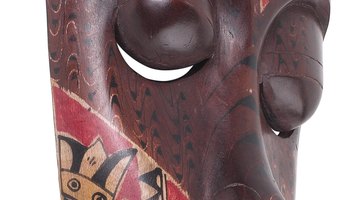What Is Polychrome Wood?
Table of Contents
Polychrome wood refers to an item that has been decorated with many colors of opaque paints and pigments. The Greek roots for this word are "poly-", meaning "many" and "chromos", meaning "color."

Through the centuries, polychrome wood items have been identified from all continents excluding Antarctica, and are still being produced today. Wooden polychrome items are common as home decor and as collectibles.
Kinds of Polychrome Wood

The ready availability of wood and the relative ease of working with it as opposed to stone resulted in wide-spread use of painted wood in architecture and in decorative and ceremonial objects. Multicolored painted sculptures of gods and religious figures are known from many cultures. Carved and painted wooden panels and ceilings decorate churches, homes and temples. Ceremonial objects like crosses, boxes and masks were brightly painted. Exteriors of wooden houses were sometimes decorated with several different colors of paints, as in American Victorian gingerbread homes exemplified by San Francisco's multicolored Painted Ladies. Practical home items such as painted dowry chests were cherished heirlooms passed from mother to daughter. Often furniture such as wooden chair backs had multicolor motifs, and carved wooden toys were decorated with paints. Decoy ducks evolved from practical hunting lures to beautifully detailed collectible art objects. Painted wooden signs identified European shops, and painted wooden Indians signaled a tobacco store. Many more examples could be given, indicating that production of polychrome wood items is limited only by the creativity and abilities of the makers.
History

Known examples of wooden polychrome items date back to ancient Egypt, when coffins, wooden sculptures and other wooden funerary items were painted with various vivid and detailed designs. It is probable that polychrome wood items were produced much earlier and elsewhere but did not survive. Ancient polychrome wood items had to be protected within tombs, temples, caves, and churches for fragile wood and pigments to escape decay. O. P. Agrawal, in his article "A Study of Indian Polychrome Wooden Sculpture," reported that although there are accounts of very early use of Indian wooden sculptures, due to the destructive climate there are no examples of polychromed wood objects before the 16th century.
Distribution

Polychrome wood is distributed throughout the world. Most cultures have developed techniques of iconographic representation in carved, painted wood of symbols and ideas that are important to them, as well as decorations that brighten functional pieces. For example, oceanic ceremonial masks, painted canoes, and cult house decorations were painted wood. Peoples of Africa, North America, Central America, South America, India, Indonesia, China, Japan, Korea and Australia as well as others produced polychrome masks. Alaskan painted totem poles were produced beginning 200 to possibly 500 years ago. Polychrome wood carvings in Chinese Buddhist temples date back to the Song period of 960 to 1279. Jesuit priests in Argentina produced polychrome carvings of saints.
Conservation
Antique and historic artifacts are the subject of intense study with high-technology tools such as stratigraphy, wood tissue analysis, gas chromatography, mass spectrometry, x-rays, and infrared analysis used for research. Curators are presented with varying and unanticipated conservation problems, such as that encountered by the deterioration of Norwegian church polychrome wood when heaters were installed for the comfort of the congregations in the earlier 1900s. It is through such studies that polychrome wood will be better preserved for future generations to enjoy.
Modern

Many folk artists and ethnic peoples on a world-wide level produce polychrome wood, although not on the level of their historic antecedants. Modern artists are producing polychrome wood works of art.
References
Resources
Writer Bio
Cathryn Chaney has worked as a gardening writer since 2002. Her horticultural experience working in the nursery industry informs her garden articles, especially those dealing with arid landscaping and drought-tolerant gardening. Chaney also writes poetry, which has appears in "Woman's World" magazine and elsewhere. Chaney graduated from the University of Arizona in 1992 with a Bachelor of Arts in English.
Photo Credits
- Medioimages/Photodisc/Photodisc/Getty Images
- Medioimages/Photodisc/Photodisc/Getty Images
- Photos.com/Photos.com/Getty Images
- Photos.com/Photos.com/Getty Images
- Hemera Technologies/PhotoObjects.net/Getty Images
- Hemera Technologies/PhotoObjects.net/Getty Images
More Articles



